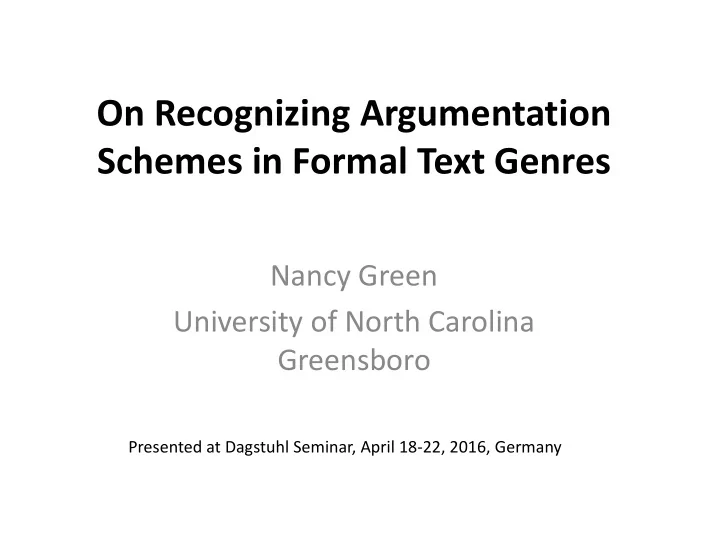

On Recognizing Argumentation Schemes in Formal Text Genres Nancy Green University of North Carolina Greensboro Presented at Dagstuhl Seminar, April 18-22, 2016, Germany
What is argumentation mining? • Surface mining : sentiment, IMRD, information status, coherence relations, premise-clause, conclusion-clause, . . . • Underground mining : – Propositional representation – Implicit/explicit premises and conclusion – Argumentation scheme – Critical question/response
State of the art • Focus on surface mining – Reuse available methods, “profitable” (useful applications), no adverse environmental impact • Little investment in underground mining: – New methods required (“higher risk”) – Long-term “profit” potential • New types of applications • Contribution to cognitive science/argumentation theory
Argumentation mining formal biomedical/biological text • Benefits – Tremendous need for scientists and clinicians – BioNLP: annotated corpora (BioDRB, CRAFT), tools (NER, Relation extraction) • Challenges – Practical difficulties, need to partner with domain experts – Some future applications require deeper knowledge representation and reasoning
Surface mining methods A B C D E F Text segments Argument layer
Surface mining methods A B C D E F Text segments Argument layer Problems: (1) text has non-contiguous, overlapping, or interleaved components of one or more arguments; (2) argument premise or conclusion may be implicit; implicit conclusion function as implicit premise later in text
Annotation of scientific text Given our interest in human neurological disease we sought to identify <span ID=“1”> any cognate human disorders where linkage had been established to the syntenic region of the human genome, </span> but where no causal mutation had been identified. <span ID=“2”> SCA15, an adult-onset autosomal dominant progressive ataxia is linked to this locus [5]. </span> <span ID=“3”> Although missense mutation of ITPR1 had previously been ruled out [2] </span><span ID=“4”> and the mode of inheritance was inconsistent with that seen in the Itpr1 Δ 18 and Itpr1opt mice, </span> <span ID=“5”> the phenotypic presence of ataxia in the mice </span> <span ID=“6”> led us to reexamine this candidate gene as a possible cause of SCA15. </span> Figure 1. Annotation of spans Green, N.L. Annotating Evidence-Based Argumentation in Biomedical Text, IEEE BIBM 2015 WS.
Definition for Annotators Argument by Analogy Premise: Property P1 of Case-1 is similar to property P2 of Case-2. Premise: In Case-1, feature F1 may be the cause of P1. Premise: F1 is similar to F2 in Case-2. Conclusion: In Case-2, feature F2 may be the cause of P2. Critical questions: • Is there a significant difference between F1 and F2? • Is there a significant difference between P1 and P2 Figure 3. Argumentation scheme underlying annotated text. Green, N.L. Annotating Evidence-Based Argumentation in Biomedical Text, IEEE BIBM 2015 WS.
Annotation of scientific text - 2 <argument ID=“argument2” scheme= “Analogy”> <premise ID=“premise1” span= “(1,2,5)” paraphrase=“ The movement disorder in the mice is similar to ataxia in humans”> <premise ID=“premise2” implicit=“yes” conclusion_of=“argument1” paraphrase= “A mutation of Itpr1 may be the cause of the ataxia-like phenotype of the mice”> <premise ID=“premise3” span=“1” paraphrase= “mouse Itpr1 is syntenically related to human ITPR1”> <conclusion span=“6” paraphrase= “a mutation in ITPR1 may be a cause of ataxia in humans”> <critical_question ID=“cq1” span=“3” paraphrase= “Is the difference between missense and deletion mutation of Itpr1/ITPR1 significant?” <critical_question ID=“cq2” span=“4” paraphrase= “Is the difference between mode of inheritance of mouse and human ataxia significant?”> </argument> Figure 2. Annotation of argumentation scheme. Green, N.L. Annotating Evidence-Based Argumentation in Biomedical Text, IEEE BIBM 2015 WS.
Propositional representation of argument • Premises: – have_phenotype(mouse, mouse_ataxia). – have_genotype(mouse, ‘Itpr1_opt’) – cause(‘Itpr1_opt’, mouse_ataxia) – have_phenotype(human, ‘SCA15’) – have_genotype(human, ‘ITPR1_mutation’) – similar(ataxia, ‘SCA15’) – similar(‘Itpr1_opt’, ‘ITPR1_mutation’) • Conclusion: cause(‘ITPR1_mutation, ‘SCA15’)
Current Work • Adding propositional representation of arguments to open-access biomedical research article in CRAFT corpus – Future unshared untask? • Defining argumentation schemes in terms of propositional representation of arguments • Bridging gap between annotation of text and propositional representation
Recommend
More recommend